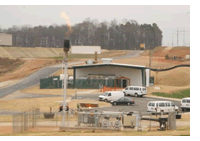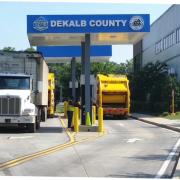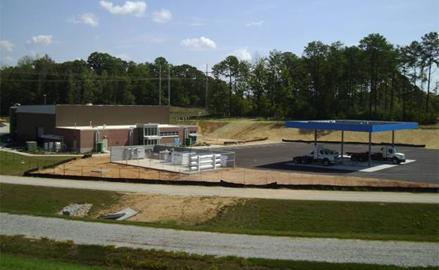
DeKalb County has a variety of properties and facilities, ranging from public libraries and recreation centers to fire stations and office buildings. All use energy, and when you add in the cost to run the fleet of county-owned vehicles, from sanitation trucks to police cars, it’s a significant part of the county budget. For example, the cost to heat and cool county buildings in 2011 was more than $17.4 million. The fuel budget to operate DeKalb’s 3,000-vehicle fleet in 2011 was $10.9 million. Along with these costs come greenhouse gas emissions related to conditioning buildings and powering vehicles. That’s why DeKalb County is taking proactive steps to increase energy efficiency and reduce the cost and environmental impact of energy use. The following information details the initiatives the county is undertaking to reduce the cost and environmental consequences of energy use.
Methane to Electricity Conversion
In 2006, the Seminole Road Landfill Green Energy Facility opened to capture and convert methane gas into electricity. Through sales to Georgia Power, this innovative operation has already earned enough revenue to offset the cost of construction. The Green Energy Facility generates enough clean energy to meet the needs of 3,000 homes annually, while removing annual greenhouse gas emissions equivalent to 3,300 vehicles. DeKalb is the only government in the state to implement such an innovative program.
To learn more about creating energy from garbage, visit this web resource:
EPA Landfill Methane Outreach Program
Methane to Compressed Natural Gas Conversion
 DeKalb County, in partnership with the Clean Cities Atlanta Coalition, received a grant of $14.9 million in 2009 from the U.S. Department of Energy for a two-year program to convert methane gas from DeKalb’s Seminole Landfill into Compressed Natural Gas (CNG). The overall goal of the program was to reduce the use of fossil fuels in transportation and lessen the national demand for petroleum. In addition to the methane conversion, the grant funded the conversion of 70 additional trash collection vehicles to run on CNG. It is estimated that this saved DeKalb more than $3 million in fuel costs over the next several years. A CNG fueling station open to the public has been constructed at the landfill.
DeKalb County, in partnership with the Clean Cities Atlanta Coalition, received a grant of $14.9 million in 2009 from the U.S. Department of Energy for a two-year program to convert methane gas from DeKalb’s Seminole Landfill into Compressed Natural Gas (CNG). The overall goal of the program was to reduce the use of fossil fuels in transportation and lessen the national demand for petroleum. In addition to the methane conversion, the grant funded the conversion of 70 additional trash collection vehicles to run on CNG. It is estimated that this saved DeKalb more than $3 million in fuel costs over the next several years. A CNG fueling station open to the public has been constructed at the landfill.
Methane to Natural Gas Conversion
DeKalb County is one of four entities that form a public-private partnership to convert methane to natural gas at Live Oak Landfill. The other partners include Jacoby Energy Development, which developed the program, Waste Management, which owns the landfill, and Atlanta Gas Light, which purchases the natural gas. The facility became operational in March 2009 and DeKalb continues to receive royalties from this venture. This project was the first methane to gas recovery system in Georgia.

Lights Out/Power Down
Turning the lights out when an area is not in use is an easy and effective way to save energy and money. DeKalb County is switching on energy savings with “Lights Out/Power Down.” This Executive Order was issued in 2009 to save energy by establishing a procedure that governs employee use of all non-emergency lighting and electronics in county facilities. The focus of this order is to increase awareness of wasted energy and to ensure that county equipment is powered down when not in use.
To see the ordinance, click here.
Alternate Fuel Vehicles: Propane, Hybrid and CNG
Propane powered vehicles are significantly cleaner than conventional gasoline and diesel powered ones because they release fewer CO2 and other emissions. They are also less expensive to operate due to the lower cost per gallon and a state tax rebate for propane use. Our Green Fleet policy gives a preference for purchasing hybrid, fuel-efficient and low emission vehicles. The county has 99 propane powered vehicles in its service fleet; nine of which server the public safety fleet as a pilot program.
Approximately $7 million in grant funds were awarded to DeKalb County in 2010 and allocated to build the new LFG to RNG facility (Renewable Fuels Facility) and CNG fueling station at the Seminole Road Landfill, as well as to replace 40 old diesel-burning vehicles with new CNG-burning waste collection vehicles. To date, the county has purchased 52 CNG units within the Sanitation Division.
The county also has two hybrid trucks that run on diesel and battery power and has plans to add two additional units. To learn more about alternative fuel vehicles, visit these web resources:
Fleet Reduction
Since 2008, DeKalb County’s Fleet Management Division has reduced the overall fleet size primarily through the reduction of under-utilized vehicles and the establishment of vehicle pools. The number of vehicles has declined from 3,745 to 3,187, a reduction of 15 percent. In 2013 an additional 48 units were taken out of service.
Reduction in Fuel Consumption
From 2009 through 2011, the county’s combined fuel consumption declined by 10 percent to 4,035,800 gallons per year. Althought fuel consumption remained relatively flat for 2012, a downward trend of 9 percent was recorded for 2013. The biggest contributor to the downward trend is the use of alternative fuels for the county's fleet.
No Idling Executive Order
According to the Environmental Defense Fund, 10 seconds of idling uses more fuel than restarting your engine. DeKalb County is taking steps to reduce carbon dioxide emissions. Executive Order 09-05 establishes a policy governing idling of county vehicles. For all but public safety and emergency vehicles, idling is limited to five minutes or less. Exceptions are made when outdoor temperatures are 93 degrees or higher and idling is needed to cool off employees at work sites. The purpose of this order is to save wear and tear on engines and to save money on fuel.
For heavy trucks in DeKalb’s fleet, excessive idling is managed by installation of automatic idle shut off equipment, which shuts off the vehicle after five minutes of idling.
To view the Executive Order, click here.
LEED Certified Buildings
In 2007 DeKalb County adopted a policy requiring that all building projects with an estimated cost of $5 million or greater be constructed to achieve Leadership in Energy and Environmental Design (LEED) certification. The county has 11 buildings that have or are pending LEED certification: Gregory Adams Juvenile Justice Center, Porter Sanford III Performing Arts and Community Center (pictured below), the Central Transfer Station, Seminole Renewable Fuels Facility, plus six new or renovated libraries and the Library Processing Center. In addition, three new senior centers and two new libraries are being designed to meet best practices that include those specified by LEED certification. To learn more about LEED certification, visit this web resource:
LEED | U.S. Green Building Council

Greener Technology for County Government
DeKalb County Information Technology (DOiT) is in the process of moving all of its old mainframe applications to web-based applications that will allow the county to eliminate its inefficient mainframe database and move to more efficient green servers. This will reduce power usage. The county is also moving its data center to a new location, and while determining the requirements of the data center it has been established that the center will be LEED certified. DOiT has also deployed a new copier fax solution that reduces the number of copiers/printers/fax machines and reduces the number of printer toner cartridges required countywide.
By using energy efficient cooling systems, racks, servers and lighting the county will reduce electric costs at the data center, which operates 24/7. Eliminating old technologies and focusing on reducing redundancy, consolidating servers and using more energy efficient equipment in a LEED-certified facility will reduce costs significantly. Also, deploying a new copier/print/fax machine comprehensive solution allows the county to track its printing costs and reduces waste. The new data center is slated for development in the Bobby Burgess Building.
Green Energy Partnerships
Energy efficiency is the easiest, fastest and cheapest action for saving energy while realizing monetary savings and preventing greenhouse gas emissions. The county’s commitment to reducing the risk of climate change relies heavily on partnerships with green organizations such as the U.S. Environmental Protection Agency (EPA).
 DeKalb County Government has been an Energy Star partner since 2009. The EPA’s Energy Star program has developed energy performance rating systems for commercial and institutional building types and manufacturing facilities. Presently, DeKalb County has more than 70 buildings logged in EPA’s database; tracking energy use, greenhouse gas emissions, and project improvements. DeKalb County’s performance contracting initiative allowed energy audits to be conducted in more than 160 buildings. The county’s energy audits help determine and prioritize projects that improve energy efficiency. Examples include updating the “Lights Out/Power Down” Policy and the installation of cool roofs on county buildings. Addressing climate change is increasingly becoming a forefront issue with government organizations.
DeKalb County Government has been an Energy Star partner since 2009. The EPA’s Energy Star program has developed energy performance rating systems for commercial and institutional building types and manufacturing facilities. Presently, DeKalb County has more than 70 buildings logged in EPA’s database; tracking energy use, greenhouse gas emissions, and project improvements. DeKalb County’s performance contracting initiative allowed energy audits to be conducted in more than 160 buildings. The county’s energy audits help determine and prioritize projects that improve energy efficiency. Examples include updating the “Lights Out/Power Down” Policy and the installation of cool roofs on county buildings. Addressing climate change is increasingly becoming a forefront issue with government organizations.
 An EPA Green Power Partner since 2006, DeKalb County’s Sanitation Division developed its first local renewable energy source at the Seminole Road Landfill. Green power is electricity generated from environmentally preferable renewable resources such as solar, wind, geothermal, low-impact biomass and low-impact hydro resources. Through the EPA Green Power Partnership, the county has powered the Gregory A. Adams Juvenile Justice Center with 100 percent renewable energy since 2009, accounting for 848,000 megawatts of electricity! It’s just another green day for DeKalb County Government.
An EPA Green Power Partner since 2006, DeKalb County’s Sanitation Division developed its first local renewable energy source at the Seminole Road Landfill. Green power is electricity generated from environmentally preferable renewable resources such as solar, wind, geothermal, low-impact biomass and low-impact hydro resources. Through the EPA Green Power Partnership, the county has powered the Gregory A. Adams Juvenile Justice Center with 100 percent renewable energy since 2009, accounting for 848,000 megawatts of electricity! It’s just another green day for DeKalb County Government.

 1300 Commerce Drive Decatur, GA 30030
1300 Commerce Drive Decatur, GA 30030
